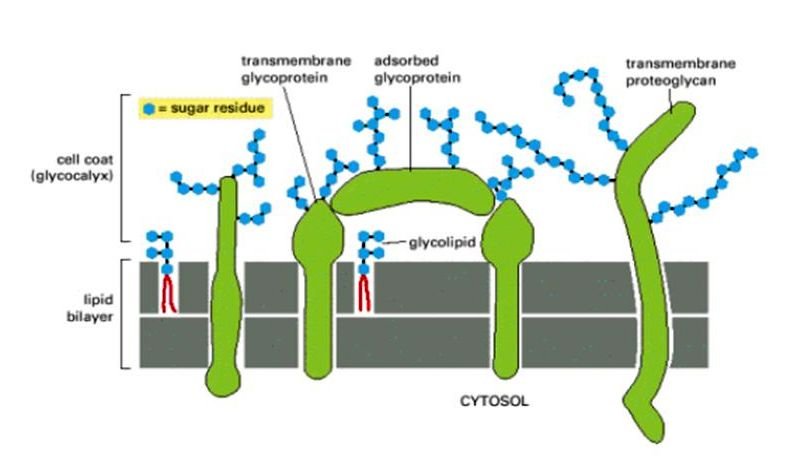Advertisements
Table of Contents
Cell Coat Definition
- The cell coat surrounds and protects the plasma membrane. The cell coat is sometimes referred to as glycocalix because it contains sugar units in glycoproteins and polysaccharides.
- The cell coat is equivalent to the oligosaccharide side chains of glycolipids and glycoproteins that are covalently bonded to protein moieties and protrude from the cell surface.
- In many types of cells, however, there is a distinct “fuzzy layer” that is formed primarily of carbohydrates and is released by the cell.
- For light microscopy, the cell coat can be stained with PAS or Alcian blue, and for electron microscopy, with lanthanum or ruthenium red. By utilising lectins, carbohydrates can be studied specifically.
- Lectins are generally plant-derived proteins that tend to attach to the cell surface and produce agglutination.
- As recognition molecules for the sugar components of glycoproteins, they are utilised. Concanavalin A is a lectin isolated from jack beans that recognises glucose and mannose residues. Germ agglutinin is a lectin that is specific for N-acetylglucosamine.
- For electron microscopy, these lectins may be tagged with fluorescent dyes or electron-dense materials.
- The cell coat is a 10 to 20 nm thick layer in close contact with the plasma membrane’s outer leaflet.
- The cell coat of an amoeba is composed of thin filaments that are 5 to 8 nm thick and 100 to 200 nm long.
- Chemically, the cell coat’s glycoproteins and gangliosides have negatively charged sialic acid termini.
- This acid has a tendency to bind Ca2+ and Na+ ions. The cell coat strength varies from cell to cell. For instance, the cell coat of the intestinal epithelium is highly robust; it resists intense mechanical and chemical attacks. In contrast, the cell coat of other cells is fragile and can be depleted by washing or exposure to enzymes.
- The cell coat is a result of the cell’s secretion that is incorporated into the cell surface and is continuously renewed.
- The glycoproteins of glycocalyx are generated on RER ribosomes, and their ultimate assembly with oligosaccharide moiety occurs in the Golgi apparatus.

Extracellular Materials
- In certain cells, extracellular materials exist outside the cell coat proper and the fuzzy layer, such as the jelly coat of fish and amphibian eggs, the basal laminae of epithelia, the matrix material in which cartilage and bone cells are lodged, and the cell wall of plant cells.
- The most prominent constituents of these extracellular materials are collagens and mucopolysaccharides (glycosaminoglycans).
Cell Coat Function
In addition to safeguarding the plasma membrane, the cell coat serves the following essential purposes:
(i) Filtration
- Sometimes, the extra coats function as filters. For example, the superfluous coatings that surround the blood capillaries of most vertebrates, particularly the kidney glomerulus, serve as a filter and govern the movement of molecules through it.
- The chemical molecule hyaluronate, which controls diffusion, is present in the extracellular coatings of connective tissue.
(ii) Maintenance of the micro-environment of the cell
- The extracellular coatings of animal cells can influence the surface concentrations of many chemicals.
- For instance, a muscle cell with an excitable plasma membrane surrounded by a glycocalyx has been found to maintain its microenvironment by trapping sodium ions.
(iii) Enzymes
- It has been discovered that the cell coat of intestinal microvilli contains a range of enzymes involved in the final digestion of carbs and proteins.
- As an example, it contains alkaline phosphatase.
(iv) Immunological properties of the extraneous coats
- Some components of the cell’s extraneous coatings possess immune characteristics.
- As an example, the plasma membrane of mammalian erythrocytes contains unique, genetically determined components (carbohydrates and proteins) that correspond to blood types A, B, and O.
- Rarely found in humans, M and N antigens are carried by the main sialoglycoproteins of the red blood cell membrane.
- The cell coat also contains influenza virus receptor sites and lectin receptor sites.
(v) Histocompatibility
- Some cell coats contain antigens that offer histocompatibility, i.e., they facilitate the recognition of cells from one organism and the rejection of cells from other organisms (e.g., the rejection of grafts from another organism).
